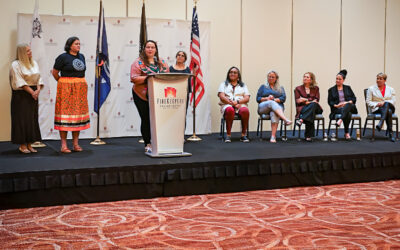Written by NHBP Environmental Director John Rodwan
Climates always change and the landscapes associated with them always adapt to those changes. Throughout history, some of these changes have been gradual, almost imperceptible in a single lifetime. Others have been more rapid, such as the changes we are witnessing today.
The Great Lakes region is a prime example of an area with a continually changing climate. In geologic terms, our land surface is a very young region. We are taught at an early age that the lakes themselves are the result of the vast continental ice sheets that melted in response to a warming climate. Those ice sheets left their large-scale record in the landforms, just as today’s climate is resulting in changing lake levels, extreme weather, and shifting vegetation.
Our area was first peopled by nomadic hunters seeking caribou, mastodons and other megafauna that thrived along the edges of the receding glaciers. These early people left a subtle record, sometimes in the stone tools they fashioned and sometimes in the sites they occupied. Their fluted stone points were used as the tips of spears to thrust into the large game they depended upon to sustain them. They were a people perfectly adapted to their environment, just as their successors adapted to their environment.
As the glaciers receded, the landcover responded accordingly. The earliest plants formed a tundra ecology, followed in time by a shrubby steppe, then coniferous forests, some of which we see remnants of in today’s northern Great Lakes. Southern Michigan was an area of transitional vegetation, dominated by hardwood oak-hickory forest and tall-grass savanna prairie dotted with individual trees and woodlots.
The area near the Pine Creek Indian Reservation had a diverse landcover due to large tracts of poorly drained soil that supported many wetlands and surface waters interspersed with higher areas that supported woodlots and oak savanna. As large animals declined, smaller animals took their place and the plant life diversified, allowing more of a hunter-gatherer lifeway. The stone tools these “middle” people left us were no longer the large fluted points, having been replaced by smaller notched chert points that were fashioned into throwing lances or arrows.
Gradually, the middle people ascended into people that became skilled at agriculture, in addition to their hunting, fishing and gathering lifeways learned from countless generations. These were a unique people that established vast trade routes, fashioned pottery, and developed complex earthworks for their gardens. Further north, the people remained more heavily reliant upon forest and fishery resources for their sustenance.
One of the dominant characteristics of the later people of what became Southwest Michigan was the use of controlled fire as a management tool within the landscapes. Fire cannot be overestimated as an agent that has shaped the environment. Naturally occurring forest fires, brush fires, and grassland fires have been a part of the environment since simple vegetation first appeared in the wake of the receding glaciers. They occurred at such regular intervals that the ecosystems evolved so that fire was directly programmed into them. Eventually the later people also became programmed with fire and established expertise in its management. This differed from the more northern forest and fisheries people who lacked the expansive and easily combusted grasslands of Southern Michigan. Fire brought fresh natural plants, herded game, and exposed rich soils for the growing of crops. These later people learned the lessons of the past extremely well. They all adapted to a changing climate and eventually grew a mastery over fire. Indeed, those that adapted to changing climates became the Firekeepers.
Stay tuned for more on Climate Adaptation from the NHBP Environmental Department.




0 Comments